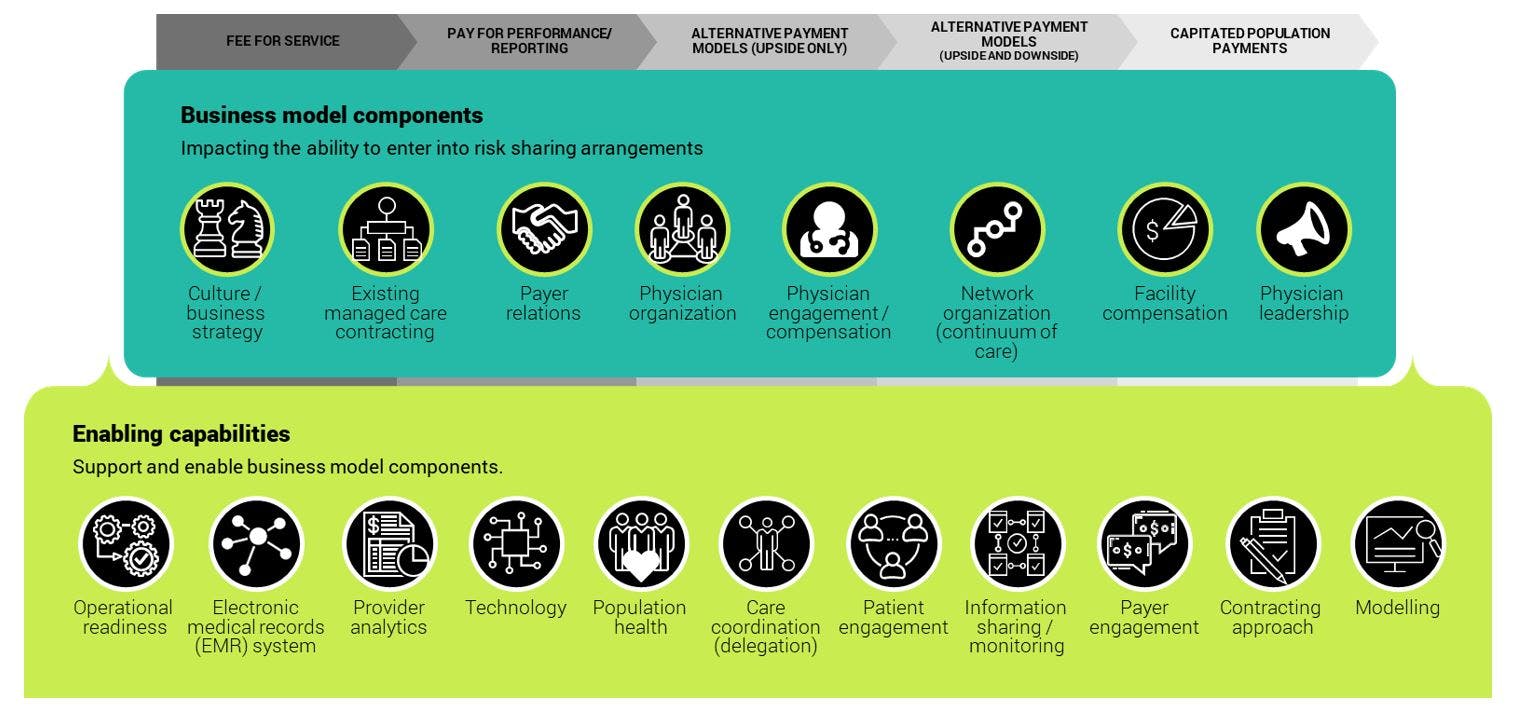


Managed care - evolution to value-based contracting
Value-based readiness model
![]()
The transformation to value-based programs involves many facets of the provider organization, from your revenue and physician compensation models to your clinical and operational workflows, documentation, analytics, and reporting. With such a widespread impact, Baker Tilly recommends establishing a value-based transformation steering committee with representation from all impacted stakeholder groups -- finance, administration, physicians, nursing, care coordination, case management, information technology etc. -- to inform, guide, and champion the change throughout the entire organization.
The steering committee serves as the overall transformation management committee, setting goals and objectives of the transformation while delegating day-to-day activities to project-based operational committees that design and implement specific initiatives to meet the within the overall transformation program.
Baker Tilly can help your organization establish an effective steering committee and provide a thorough transformation roadmap based on the organization’s specific goals. We conduct a comprehensive readiness assessment of all aspects of your organization that identifies areas of foundational strength while clearly describing where the organization needs improvement to maximize its success in value-based programs.
Define Your Strategy
Baker Tilly’s approach to defining your strategy uses a detailed assessment tool that evaluates your organization’s preparedness against our comprehensive value-based transformation roadmap. The assessment provides insight into the readiness of your core business model components and enabling capabilities, and targets recommendations based on what types of value-based programs your organization intends to support.
Process Considerations: Moving to Foundational Value-Based Programs
Value-based programs fall along a continuum of risk from payment for volume to payment for value, with clinical and financial integration and resources needed for success increasing along with the risk and rewards for each payment model. Foundational value-based programs include pay for performance and alternative payment models that provide incentive for better patient outcomes and upside payment potential. Your organization should consider the following when moving from foundational fee for service contracts to these new models.
- Identify provider leadership
- Identify attainable goals and objectives
- Build a vision for value-based care
- Perform SWOT analysis
- Identify the capabilities of current and planned IT resources
- Develop an action plan
- Educate and train all staff
- Implement processes for care coordination and care management, monitoring utilization and integration
- Develop/enhance quality and patient satisfaction programs
- Articulate/draft a proposal to a targeted payer
- Negotiate VB contract with upside risk only (e.g., P4P, bundled payments, shared savings; can limit to a single service)
- Initiate payer alignment (i.e., payer with whom provider has an established relationship that can be developed into a partnership, and has service volume)
- Share data among stakeholders; build databases and establish reporting
- Track quality, performance and clinical outcomes of internal and external providers
- Renegotiate based on successes/experience
Process Considerations: Moving to Advanced Value-Based Programs
Advanced value-based programs tie outcomes and performance directly to payment – with your organization assuming potential downside risk while offering higher upside potential if the organization is effectively managing outcomes. These models include programs such as bundled payments, episodes of care, and ultimately full capitation models. Your organization should consider the following when moving to advanced value-based models:
- Build on lessons learned from upside risk contracting, i.e., utilization and cost experiences from upside risk contracts
- Employ consultants and/or vendors to assist in managing risk
- Learn from CMS programs
- Assess population size appropriate to assume/manage risk and mitigate losses
- Negotiate partial downside risk alongside upside risk
- Share data with payer
- Implement strong medical management, provider accountability in delivering timely, best care in the appropriate setting
- Review/understand reconciliation process
- Account for patients receiving care from other providers
Baker Tilly’s strategic approach in action
Baker Tilly’s value-based readiness assessment provides a comprehensive analysis and program roadmap for your organization to implement a transformation to value-based contracting. Our approach recommends specific actions based on your preferred value-based goals (from upside only options to full capitation).
- Our team of value architects develops a framework and roadmap that operationalizes your vision and strategy with a value proposition tailored to your strengths. For example, your organization has the top performing orthopedics service in its market, and a successful contracting approach may first focus on developing bundled payment programs around that orthopedics service line.
- Analyze and recommend contractual relationships that are mutually beneficial. Baker Tilly helps your organization determine which payers in your market will work with you to develop value-based programs that play to your strengths, and which provider groups are interested in value-based partnerships with a commitment to quality, cost, and outcomes.
- Provides relevant and focused recommendations across eight key business model components and 11 supporting enabling capabilities. Our roadmap realigns business processes with your strategy and engages leadership across the continuum in driving successful change. For example, value-based programs define performance metrics that require new reimbursement models and physician compensation processes aligned to deliver effective patient outcomes and quality/performance metrics.

